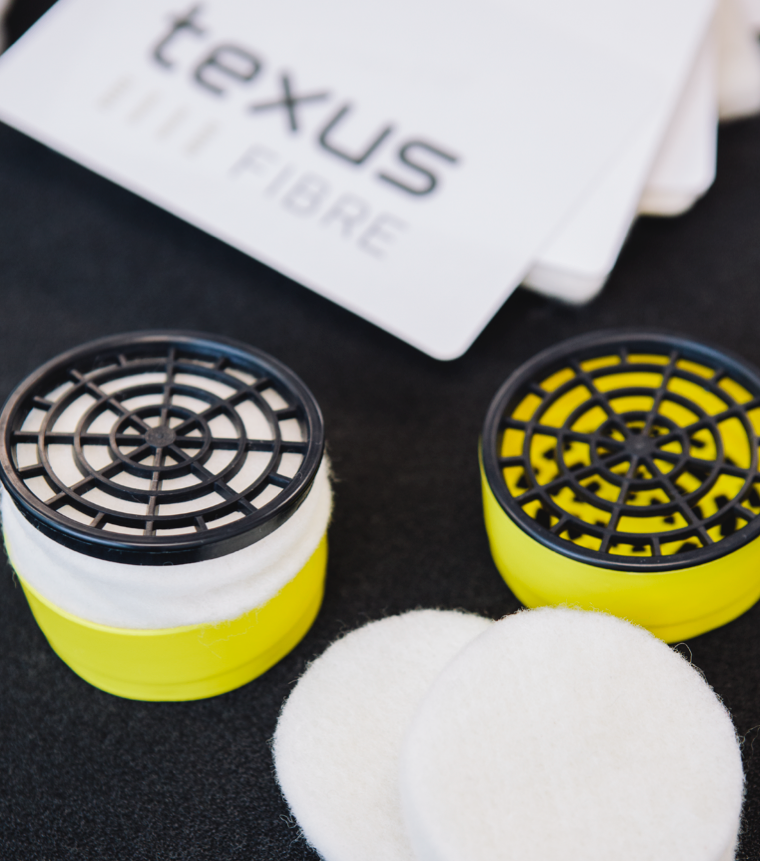
Wool media is a game changer – and Texus Fibre is playing for keeps.

Wool composite electrostatic filter elements for personal particulate respirator masks. (Say again?) PHOTO: Simon Wilson
American Steve Weinstein, a global woolcentric sourcer at S2W in the US, had long been coming to New Zealand from the US to buy up wool. When his fishing buddy and local businessman Nick Davenport went to visit him in New England, he couldn’t help but notice the place smelled of wool – and he got a few lessons in the quintessentially Kiwi fibre of his homeland.
“He had samples in every room and he told me everything I should have known about it as a Kiwi,” Davenport says. “It’s not only what keeps sheep warm or what we make carpet or clothing out of, it’s an incredibly functional fibre.”
Davenport has now mobilised an army of collaborators, resources and funding for a charge into the global market for wool-
based fibre materials used in manufacturing. The troops have gathered around two-year-old venture Texus Fibre, launched off the back of Auckland company Nexus Foams, where Davenport is managing director. Nexus has 20 years of expertise turning soft fibres of a different kind – plastic – into industrial components.
=
So what’s the big deal about making industrial materials from wool blends? Davenport can name a few. Wool regulates temperature and humidity, is fire-retardant, resilient, combines well with other materials and absorbs sound and volatile organic compounds that can be dangerous to humans and the environment. Texus’ products harness the alpha helix DNA molecule embedded in wool, so it stays drier and products perform at optimum levels for longer.
Media for personal respirators is the ‘easy entre?e’ Texus is targeting in the world market. Filtration is a vast and fast-growing market globally, with applications in everything from face masks worn on the street to hazardous industrial environments.
“In terms of filter media and non-woven filter media, the specific sector that we’re looking at is worth $3.6 billion globally, growing at about seven percent annually, and that’s not the whole non-wovens sector,” Davenport says.
“Non-wovens themselves are growing hugely globally. We’re not naive to the fact it’s a very hot and interesting area of investment for a lot of industrialists around the world. The merger and acquisition activity in that area is huge.”

Managing director Nick Davenport, product development engineer Shaun Tan and chief financial officer Tracey Swinehart. PHOTO: Simon Wilson
Wool media is a game changer and a worthy rival to synthetic materials for filtration products, Davenport reckons. That’s because wool-based filter media has extremely low pressure resistance, but high particle capture. If worn, that means it’s easy to breathe through but still protects well from dust and pollutants. If it’s an air conditioning filter in a building, that low resistance means lower power consumption, which is economically attractive for property owners. And natural fibre doesn’t create soil pollution when it’s made into products or when those products are recycled at the end of their life.
Wool’s sustainable properties are helping the cause for The Formary, another Kiwi company using wool in a fabric blend for the global market. The Formary is stirring demand for a wool/rice straw blended fabric and co-founder Bernadette Casey sees big growth prospects for wool as an alternative to synthetic fibre.
“People have to do a lifecycle analysis,” she says. “That’s where the textile industry is going. People want to know how long the lifespan is and once it’s reached the end of its current incarnation, what’s involved in recycling it.”
The possibilities for Texus’ wool-based filters extend to medical filters for patients and filtration for planes, trains and automobiles.
When Texus was set up, Davenport decided Christchurch, the heart of the Kiwi wool industry, was the best southern base. Shortly before the February 2011 quake he and Malcolm Corbett, former managing director of recycled wool products company Terra Lana, bought the Lincoln-based R&D plant formerly owned by AgResearch and installed it in one of Texus’ two Christchurch factories.
The relationship with AgResearch began when Texus enlisted the government organisation as a subcontractor for a successful tender to make air filters.
Another contracting deal, this time between Texus and an Australian wool broker, kickstarted the second platform for the fledgling fibre business. That one was with Australia’s national science industry organisation CSIRO, which had been researching value added wool for industrial applications. Davenport realised his company needed to acquire that IP to develop a range of new products.
Texus Fibre now has funding from the Global From Day One fund alongside that of Nexus, and half a million dollars in revenue from two customers: PPE Suppliers in South Africa and Scott Safety, a Tyco company in Australia.
“That’s small fry compared to where we’re going to go,” says Davenport. “We have several projects, all focused on specific markets and specific technologies and specific IP, which is going to further that.”
Last November Davenport went to the 15th annual China High-Tech Fair to assess demand for its Helix filter in a region where concerns over dust and its toxicity are growing. He also met potential investors there ahead of a capital raising round he hopes will attract global interest.
Texus continues to work with AgResearch and CSIRO and partners with Tauranga firm Locus Research on strategic commercialisation. It also has agreements with half a dozen local companies to work on fibre technologies of benefit to Texus and those firms, says Davenport, but it’s too soon to name them.
The goal is to reach $100 million in turnover in the next 10 years, but because Texus is relying on trade secrets ahead of any IP protection, much of how it will get there has to be kept under wraps.
What can be said is that top talent is part of the strategy. Texus has hired Shaun Tan, a PhD student based at the University of Auckland’s Centre for Advanced Composite Materials, who was a member of the Ecofibre team that won the university’s Spark Challenge last year.
Controlling the fibre source is another key plank. Texus has memoranda of understanding with grower groups on both sides of the Tasman, but the attributes the wool has to have is still hush-hush.
“If we could tailor a fibre to a specification and that was locked in its DNA, another company isn’t going to be able to grow it in 10 years,” says Davenport. It’s down to Texus’ research programme to find out if that’s possible.
Texus wants its technology platform to have a quality mark that’s recognised and valued by manufacturers.
“We have a very broad programme from growing a fibre to how the customer perceives that fibre as an ingredient in someone else’s product,” Davenport says. “We want the Texus Fibre helix, the intel inside, to be identified and have that marketing message embodied in a real brand truth. If [someone] buys that, they know it’s DNA linked to that performance attribute, and it’s grown for them, and it’s good for them.”




